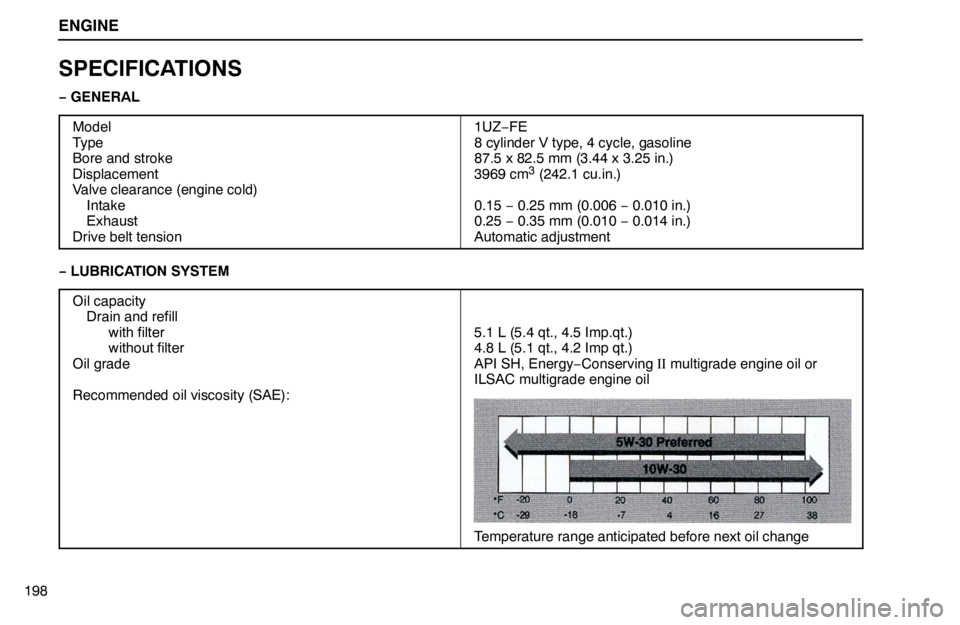ENGINE
198
SPECIFICATIONS
− GENERAL
Model
Type
Bore and stroke
Displacement
Valve clearance (engine cold)
Intake
Exhaust
Drive belt tension
1UZ−FE
8 cylinder V type, 4 cycle, gasoline
87.5 x 82.5 mm (3.44 x 3.25 in.)
3969 cm
3 (242.1 cu.in.)
0.15 − 0.25 mm (0.006 − 0.010 in.)
0.25 − 0.35 mm (0.010 − 0.014 in.)
Automatic adjustment
− LUBRICATION SYSTEM
Oil capacity
Drain and refill
with filter
without filter
Oil grade
Recommended oil viscosity (SAE):
5.1 L (5.4 qt., 4.5 Imp.qt.)
4.8 L (5.1 qt., 4.2 Imp qt.)
API SH, Energy−Conserving II multigrade engine oil or
ILSAC multigrade engine oil
Temperature range anticipated before next oil change
ENGINE
201
Gasolines containing alcohol
Gasohol is a mixture of gasoline and ethanol. If you use
gasohol in your Lexus, be sure that it is unleaded, has an
octane rating no lower than 87 and does not contain more
than 10% ethanol. Lexus does not recommend the use of
gasolines containing methanol.
If you use gasoline containing methanol, use only gasoline
meeting the requirements above and also containing less than
5% methanol with cosolvents and corrosion inhibitors for
methanol
NOTICE
�Do not use gasohol other than stated above. It will
cause fuel system damage or vehicle performance
problems.
�If drivability problems are encountered (poor hot
starting, vaporizing, engine knock, etc.), discontinue
its use.
�Take care not to spill gasohol during refueling.
Gasohol may cause paint damage.
Fuel tank capacity
85 L (22.5 gal., 18.7 Imp.gal.)
FACTS ABOUT ENGINE OIL
CONSUMPTION
Functions of engine oil
Engine oil has the primary function of lubricating and cooling
the inside of the engine, and plays a major role in maintaining
the engine in proper working order.
Engine oil consumption
It is normal that an engine should consume some engine
oil during normal engine operation. The causes of oil
consumption in a normal engine are as follows.
�Oil is used to lubricate pistons, piston rings and cylinders.
A thin film of oil is left on the cylinder wall when a piston
moves downwards in the cylinder. High negative pressure
generated when the vehicle is decelerating sucks some of
this oil into the combustion chamber. This oil as well as
some part of the oil film left on the cylinder wall is burned by
the high temperature combustion gases during the
combustion process.
�Oil is also used to lubricate the stems of the intake valves.
Some of this oil is sucked into the combustion chamber
together with the intake air and is burned along with the fuel.
High temperature exhaust gases also burn the oil used to
lubricate the exhaust valve stems.

